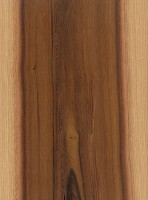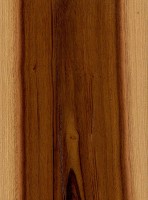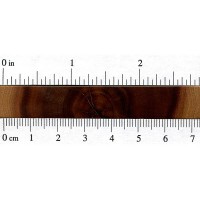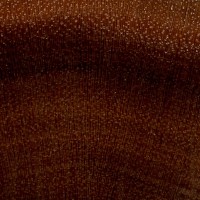 |
Common Name(s): Black Ironwood, Leadwood Scientific Name: Krugiodendron ferreum Distribution: Southern Florida, Caribbean, and Central America Tree Size: 20-30 ft (6-9 m) tall, .5-1 ft (.2-.3 m) trunk diameter Average Dried Weight: 84 lbs/ft3 (1,355 kg/m3) Specific Gravity (Basic, 12% MC): 1.07, 1.35 Janka Hardness: 3,660 lbf (16,280 N) Modulus of Rupture: 18,200 lbf/in2 (125.5 MPa) Elastic Modulus: 2,966,000 lbf/in2 (20.46 GPa) Crushing Strength: 9,940 lbf/in2 (68.6 MPa) Shrinkage: Radial: 6.2%, Tangential: 8.0%, Volumetric: 11.6%, T/R Ratio: 1.3 |
Color/Appearance: Black Ironwood’s heartwood can be a range of reds, oranges, violets, and browns. Pale yellowish white sapwood is clearly demarcated from heartwood.
Grain/Texture: Black Ironwood has a straight and even grain with a very fine texture and high natural luster.
Endgrain: Diffuse-porous; small to medium pores in no specific arrangement, moderately numerous; solitary and radial multiples of 2-3; gum deposits in heartwood pores present; growth rings usually indistinct; narrow rays not visible without lens, close spacing; parenchyma vasicentric.
Rot Resistance: Reported to be very resistant to decay, and also resistant to termites.
Workability: High cutting resistance, and difficult to work due to density. Turns and finishes well.
Odor: No characteristic odor.
Allergies/Toxicity: Besides the standard health risks associated with any type of wood dust, no further health reactions have been associated with Black Ironwood. See the articles Wood Allergies and Toxicity and Wood Dust Safety for more information.
Pricing/Availability: Black Ironwood tends to be a very small tree, barely exceeding the size of a shrub. Because of it’s small size and high density, it’s not sold commercially. Small pieces may be available for hobbyist or specialty purposes within its natural range.
Sustainability: This wood species is not listed in the CITES Appendices or on the IUCN Red List of Threatened Species.
Common Uses: Firewood, veneer, and small turned objects.
Comments: Among the heaviest woods on earth, Black Ironwood is found in southern Florida, making it the heaviest wood in the United States, (along with the unrelated Desert Ironwood perhaps being a close second).
None available.
 |
 |
 |
 |


There is a wood that could be very dense it is Tubi from the Solomon Islands. It is also a seldom seen black wood.
Has anybody managed to work on this wood. I am curious to how bad it resists cutting. Is sanding the only way around it? That would take a lot of time as you probobly would unintentionally heat up the wood if sanding s the only way to go.
Like anything super hard just step up the cutting angle. I’m from Australia. Everything here is super hard. 25° would be a low cutting angle. Just step it right up.
Odour of black iron wood= ‘no characteristic odour.’ What is the meaning of this statement?
Just means that it doesn’t have a distinct smell, like some woods do when cut. Probs just smells woody
Eric, hi.
In the description of Black Ironwood (Krugiodendron ferreum) in Wikipedia (https://de.wikipedia.org/wiki/Krugiodendron_ferreum) I came across a certain paradox: in the “Usage” section, one of the names is referred to as Quebracho, but this name already exists in Schinopsis (https://www.wood-database.com/quebracho/). How can you comment on this contradiction? And does Black Ironwood really have that name in the United States?
Common names contradict each other all the time. Ironwood is a great example, as the term means different things depending on where you are in the world. I’ve never heard of this wood being called quebracho though, but I could see in Spanish speaking regions where that might be a name for it. In the US, while not a common wood, I’ve only ever seen it referred to as black ironwood.
“Quebracho” is a generic term for extremely hard woods, it means ‘axe breaker’ in Spanish.
will it sink in water
Yes
It will sink like a rock. The pcs I have found is black and brown, and not very easy to find.I have never found a live tree and the pcs we find are dead usually in mud water but are hard and solid. Some pcs are jet black with glossy surfaces../
A good and fine wood is used for high-end furniture, however we usually import them from South Africa and Laos.
Is the density correct? You have it as denser than lignum vitae, which says it is the heaviest wood on earth.
Yes. This is THE densest wood on earth.
My measurements of two samples says: S.G. 1.26 and 1.27
What is the borer resistance of this wood
can I make a ruler out of it?
I dont see why not.
I wondered if it could be used for the smoking pipes making as briar wood.
tabacco is trash
Weed, then :-) ??